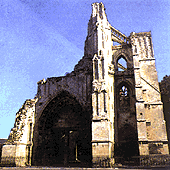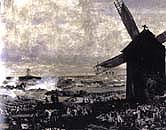Places
to visit
| Background
information |
Find
a book about it French
Revolution 1789
Transport
& the problem of feeding Paris

Storming the
Bastille
Revolutionary Wars
1792-1794
Napoleon and the
North
|
The French revolution in 1789 was a defining moment in French society. This page describes some of the events of the Revolution, the Napoleonic Wars and the First Empire - setting what happened in Nord Pas-de-Calais in context. |
|
|
|
Transport & the problem of feeding
Paris Between the French capital and Nord-PasdeCalais, the
country's most fertile agricultural
area, lay 200km of poor roads. Carting doubled the cost
of bulk goods like grain every 55km. Canals could have
carried food much more cheaply, and could have opened up a
market for heavy coal to replace firewood as fuel. |
|
|
Food crisis
A labouring family of four ate 1.2 tons of grain a year - 80% of that came from the Paris basin. In the 1780s a series of poor harvests in the area led to soaring bread prices, provoking food riots. Coastal cities could import supplies, but in Paris, a worker's daily bread took 97% of his income. The worst time was July, just before the next harvest. Storming the Bastille |
|
Revolutionary
zealots destroy church property |
|
|
Revolutionary Wars
1792-1794 British King George III sent an army to Holland in 1793, commanded by his son, the Duke of York. With Austrian armies from the neighboring Netherlands, they besieged French border forts in the Lille area, capturing Valenciennes. The foreign threat provoked a patriotic enthusiasm to defend France by spreading the revolution. Many volunteers joined the Revolutionary armies. When the British/Austrian/Hanoverian troops marched to try and capture the port of Dunkerque (to secure their supply lines from Britain), they were defeated at the battle of Hondschoote in September. British troops were gradually withdrawn, e.g. to fight in the rich sugar plantation colonies in the West Indies. In the spring of 1794, the Revolutionary Armies inflicted further defeats on the Austrians along the French borders, e.g. at Roubaix, and went on to capture the Austrian Netherlands - what is now Belgium - which remained French until 1814. |
|
|
|
The Terror and the
guillotine Committees of Public Safety sought out supposed traitors,
spies and aristocrats-in-hiding. People like Robespierre
in Arras wielded enormous power through spell-binding
speeches that directed mob anger against supposed enemies of
the revolution. |
|
Napoleon and the
North While planning his invasion of Britain, Napoleon spent some time in Boulogne. From 1810 the Continental Blockade gave Nord - Pas-de-Calais an opportunity to develop new industries, by freezing out British competion. The cotton industry flourished, new coal mines were opened, and the cultivation of sugar-beet replaced cane-sugar which could no longer be imported across the Atlantic. But continuing conscription, shortages and the miseries
of endless wars made Napoleon's rule less and less poipular
in the North. With his defeat in 1815, the region suffered
an army of occupation for 3 years. In 1830 the neighbouring
Netherlands provinces revolted against rule by the Dutch and
became a separate country, Belgium. |
|
|
|
|
|||
|
Places to
visit: |
||||
|
Related background
information |
|
|
|
|
|





